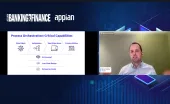
Why tech is not the focal point of banks’ digital transformations
About 70% of digital transformations fail, an industry expert warned.
One trillion dollars are expected to have been invested by financial institutions in digital transformation by the end of 2024. Most of this money, however, might fail to bring any value to the organisation, a managing consulting firm director told Asian Banking & Finance.
“Seventy percent [70%] of digital transformations fail, often because of organizational silos, and the insular thinking within an organization, that makes it difficult to collaborate across the organization,” Douglas Jackson, managing director and head of Vietnam for the management consulting firm Alvarez and Marsal, told attendees of the 2024 iteration of the Asian Banking & Finance Forum held in Hanoi, Vietnam.
Jackson joined as the moderator of a panel discussion on unlocking growth through digital innovation strategies.
ALSO READ: How banks should rethink pricing
Tech not the core point
One major takeaway is that the core part of a digital transformation is not the technology.
“I would say the tech part is not the core point,” noted Fabien Sanchez, chief sales officer, Home Credit Vietnam.
Sanchez noted that whilst organisations in Vietnam are worrying about back system integration and other technical points that they may be neglecting an important part of supporting customers through their transformation. He particularly noted how, three years ago– during the height of the pandemic that pushed customers to digital channels– their online finance business in Vietnam was not performing as good as their other businesses in neighboring countries.
Home Credit Vietnam found that the solution was not in the tech aspect, but in the customer side.
“We decided to work on education, transparency, and trust. Because what is lacking for this digital transformation and to speed [it] up, is the trust of the customers,” Sanchez said.
He also highlighted the importance of partnerships.
“This is not very common in Vietnam,” Sanchez admitted. “Everyone is competing with each other. “I can't be your partner, you're my competitor.” But in this world, this is really important. Partnership in innovation technology, but partnership as well in ecosystems. These are the both areas we're already intensifying and working on in the last [few] years.”
ALSO READ: Zed challenges banking norms with no interest, forward-looking credit card
Eliminating inconveniences
For the tech part, the challenge is keeping it seamless by limiting customer inconveniences. Nguyen Duc Binh, chief technology officer for DNSE, said that their first order of business when they first acquired the company mid-2020 was to streamline the customer onboarding process.
“One of the first things that we wanted to address when we established our brokerage firm was to eliminate that inconvenience for the customer,” Nguyen told attendees.
“This was not as simple as it sounded, as it included ensuring the security of the customers’ identity. We basically [made] sure that the person in front of the phone is a real person and not some deepfake or pictures and videos and other things, and then matching that person with the photos on their identity card,” he said.
This, along with implementing digital signatures, allowed DNSE eliminated the need for customers to go to a physical branch. The move made DNSE one of the first brokerage firms in Vietnam to have a fully online registration process.
“[It] takes about two to three minutes, and after that, the customer can start trading right away,” Nguyen shared.
Partnerships
For banks with legacy and systematic importance, HSBC Vietnam’s chief operating officer Phil Wright highlighted the importance of partnerships in order to successfully deliver technology innovations at scale safely.
“Partnerships between the financial institution with the regulator and with technology vendors and partners. I think that's the key and most safe way to deliver a lot of these technology innovations at scale,” Wright said.
Wright admitted that these partnerships are also a cause of concern for banks’ risk management controls.
“Banks are becoming ever increasingly reliant on third-party vendors,” he noted. “I can control what's right in front of me. I can put frameworks to manage the risk of those third parties. But ultimately, I'm not there. I'm not able to see exactly what goes on,” Wright said, adding that the threat of data leakages and malware attacks from third party vendors has driven HSBC to put a lot of time in addressing third-party risk management concerns.
ALSO READ: Banks grapple through era of disruption by being the disruptor
Wright also shared that rolling out a safe and effective digital transformation means that they may not always be the first to roll out a service using emerging technologies.
“We’re a global, systemically important bank. That means, among other things, [that] we're held to a very high regard when it comes to technology resilience and technology risk management. There will be some emerging technologies, and we know they're game changers for the industry. But we might not be first to deploy them. We might be second, third, fourth. Because we're sitting there, we're looking at what's happening, we're looking at the trends, we're observing the risks,” Wright shared.
Excitement and caution
Nguyen Vinh Tuyen, deputy general director and director of the IT division for Nam A Bank,reminded attendees that emerging technologies and digital innovations should both be approached with excitement and caution.
“One is the open banking or open API,” Nguyen said, when asked what he looks forward to in the future. “We want to open our platform so that customers from everywhere can access trading, we want outside partners to connect with us so we can provide a better service for the customer–whether they came from DNSE, or Namavang, or HIPC,” he added.
But he also recognized that there’s a lot of risks that come into play when banks open their platforms for third party partners to integrate into.
Generative AI is another trend that will enable banks to provide smart, customised, and personalised services to Nam A Bank’s investors, he said.
















 Advertise
Advertise






